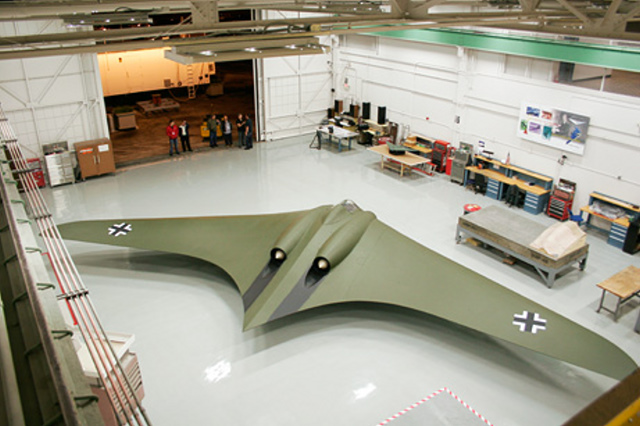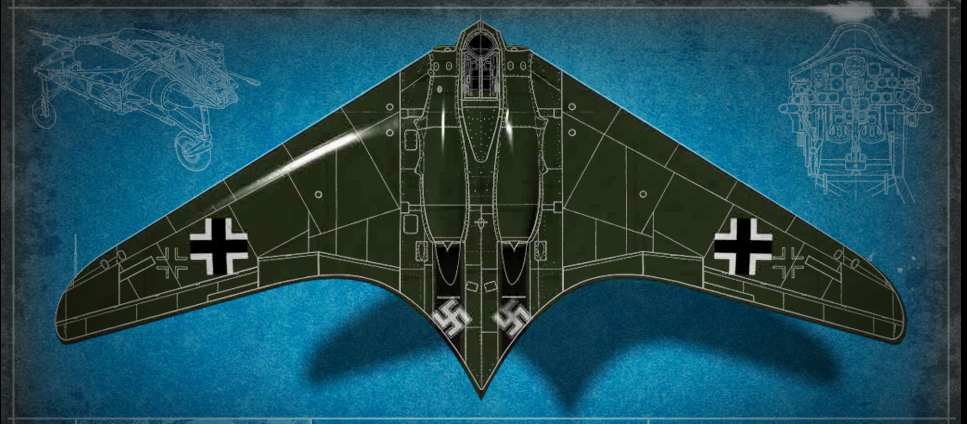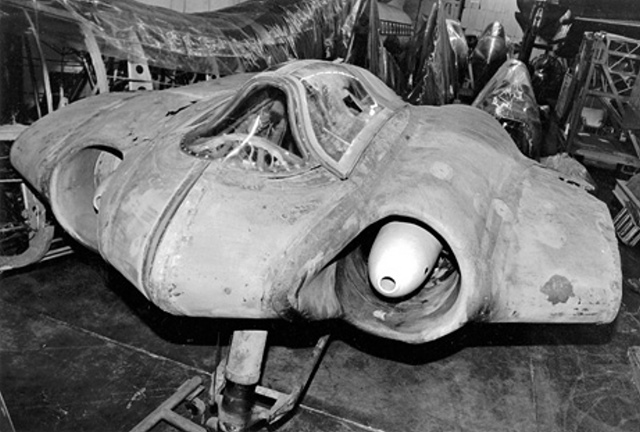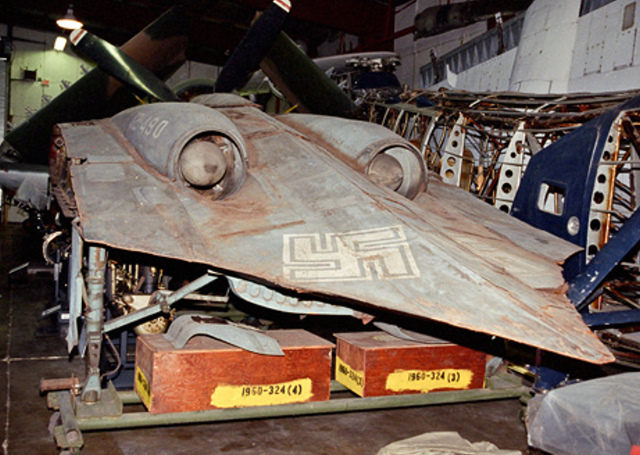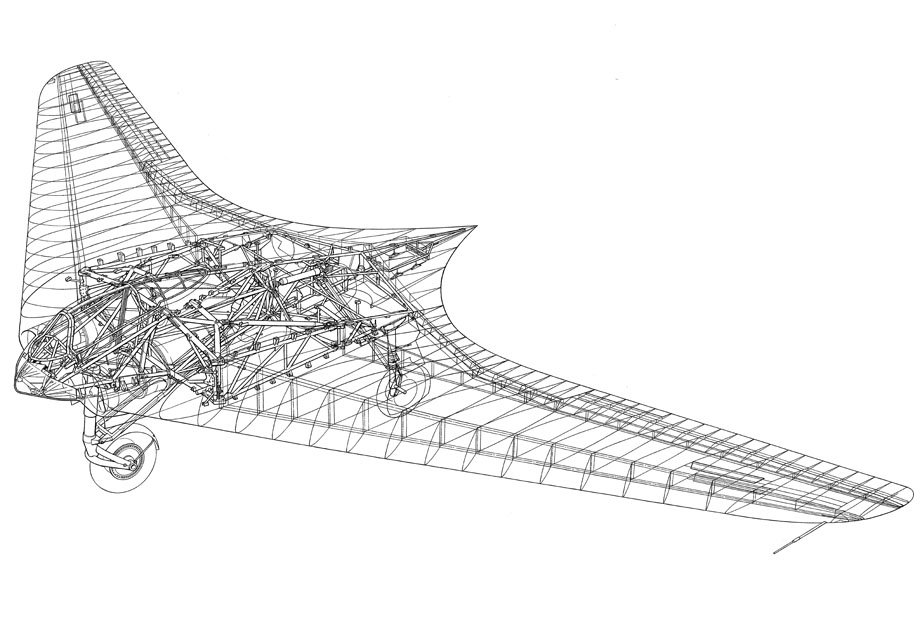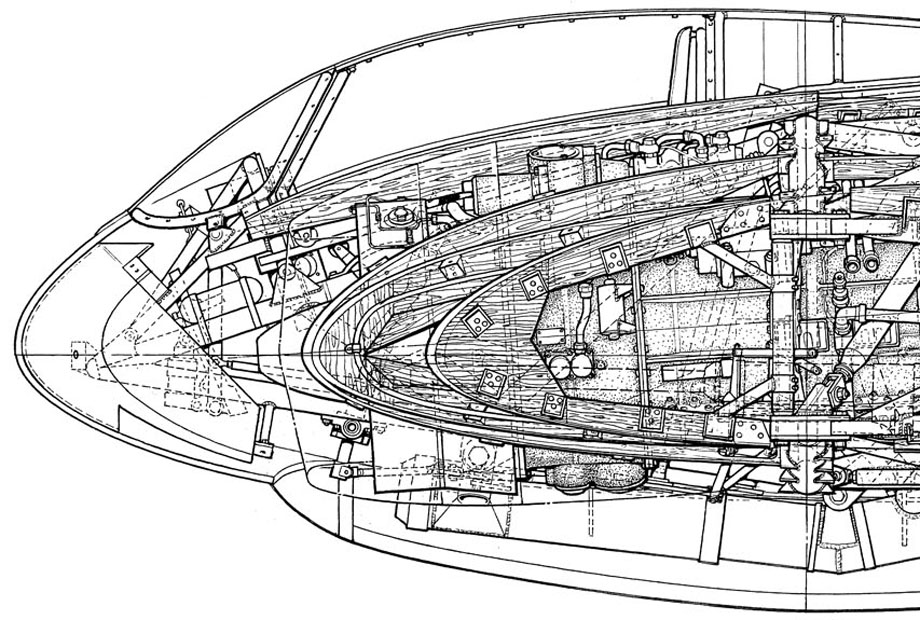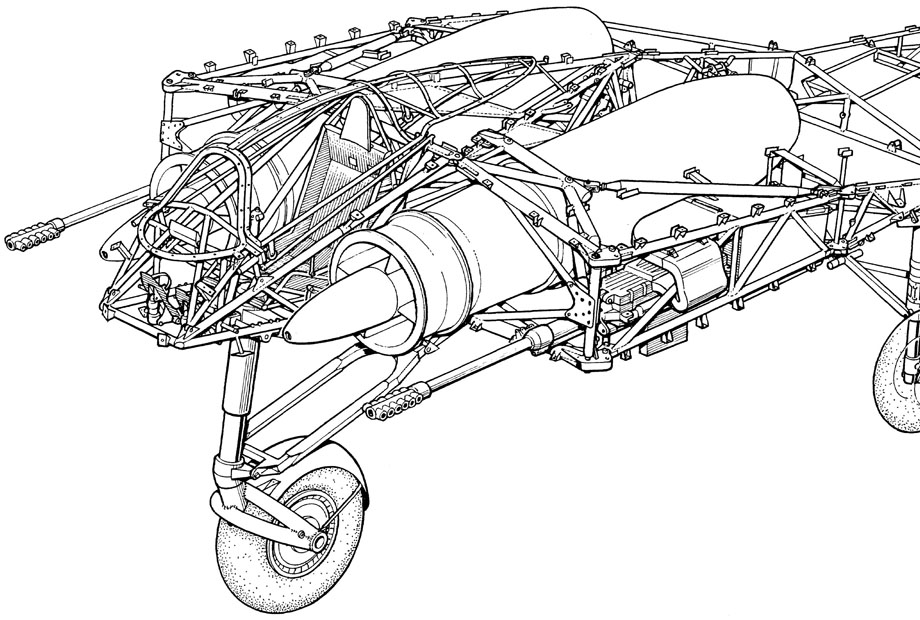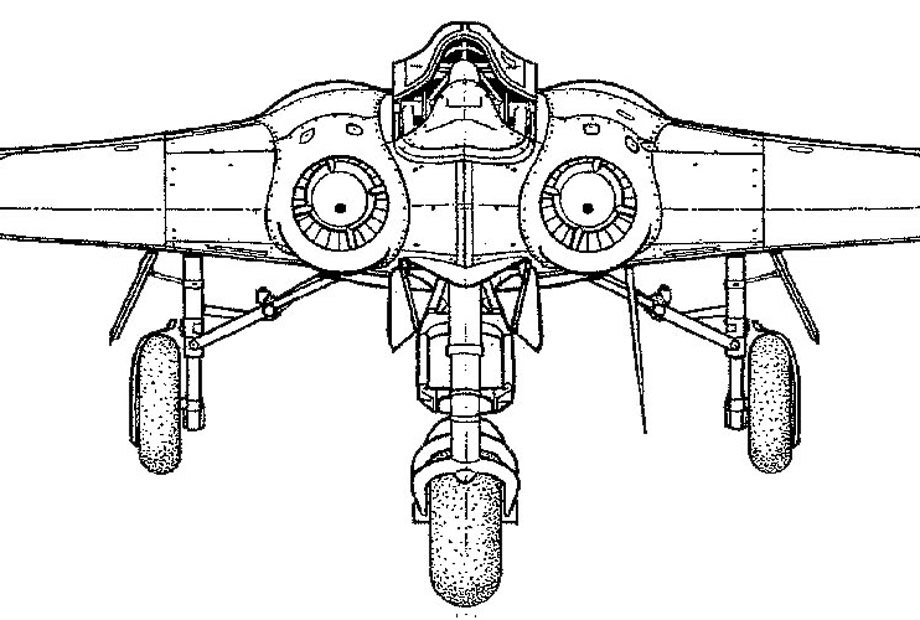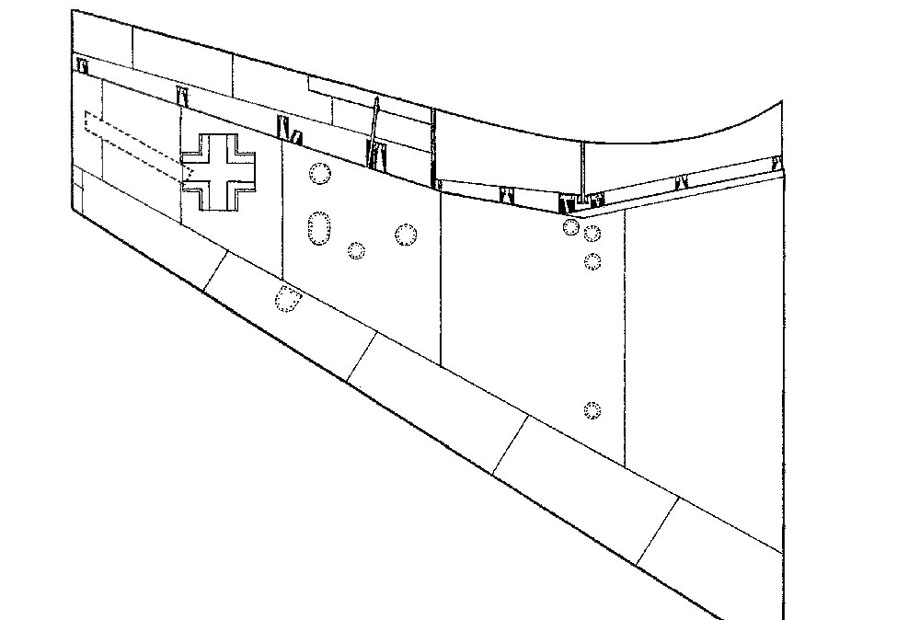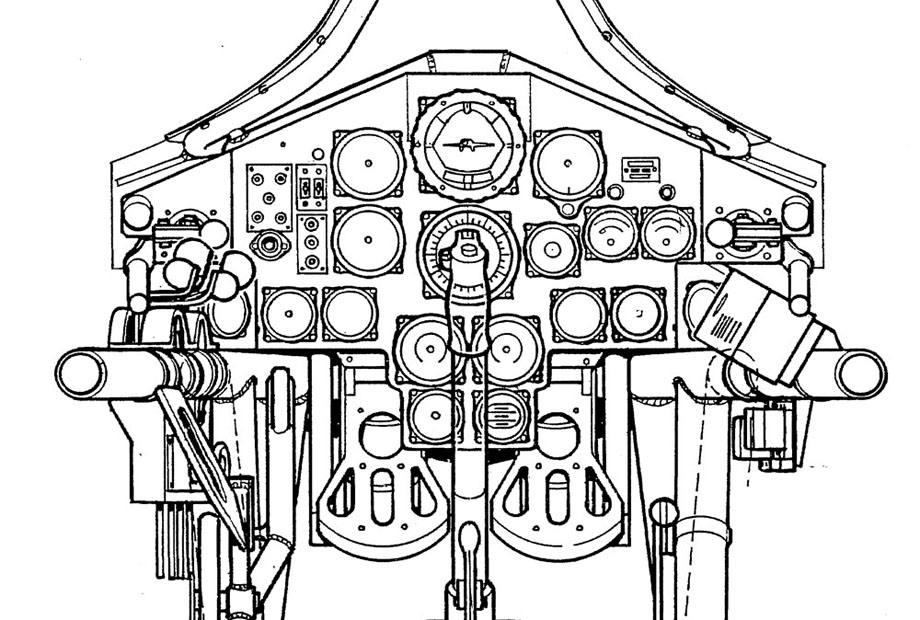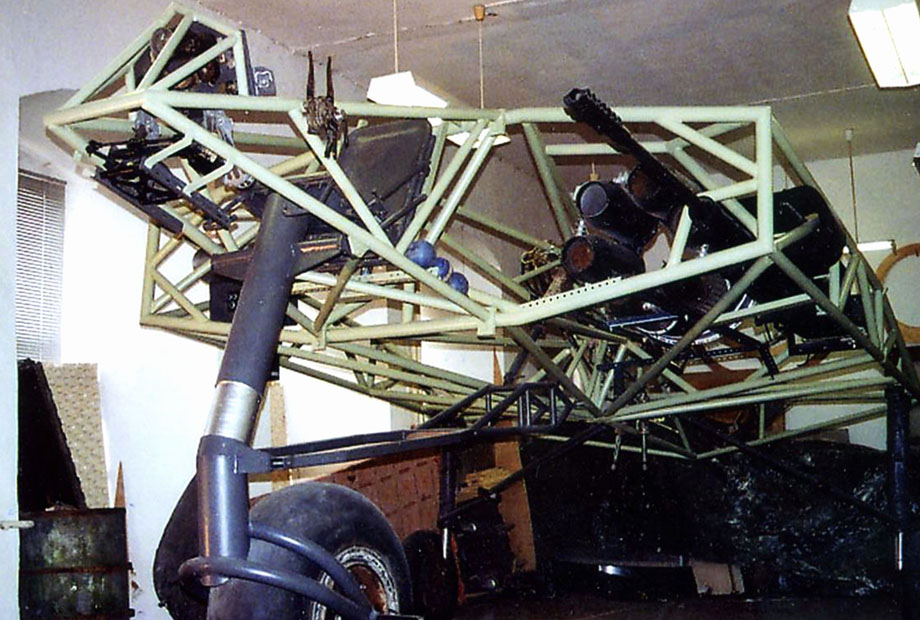|
Flying Wings |
|||||||||
|
..
July 25, 2009--At a Northrop
Grumman facility in California, top stealth-plane experts admire their
handiwork in late 2008—a full-size, though flightless, replica of a Horten
2-29, aka Hitler's stealth fighter, created for a documentary airing June
28 on the National Geographic Channel. The team tested the re-created Nazi
jet against World War II-style radar. With its radar-resistant design and
600-mile-an-hour (970-kilometer-an-hour) speed, the team concluded, the
Ho 2-29 would have allowed British antiaircraft forces only 9 minutes to
respond, versus 18 with a conventional World War II fighter. Had Hitler's
stealth fighter made it into mass production, the plane could have changed
to course of the war in Europe, experts say. Credit: National
Geographic Society
"Hitler's Stealth Fighter" Re-created
Top stealth-plane experts have re-created a radical, nearly forgotten Nazi aircraft: the Horten 2-29, a retro-futuristic fighter that arrived too late in World War II to make it into mass production. The engineers' goal was to determine whether the so-called stealth fighter was truly radar resistant. In the process, they've uncovered new clues to just how close Nazi engineers were to unleashing a jet that some say could have changed the course of the war. To replicate the Ho 2-29 late last year for a documentary premiering Sunday, a team from the Northrop Grumman defense-contracting corporation used original Nazi blueprints (see re-created blueprints of Hitler's stealth fighter) and the only surviving Ho 2-29, which has been stored in a U.S. government facility for more than 50 years. The all-wing Ho 2-29 looked more like today's U.S. B-2 bomber (Below)—or something from a Star Wars prequel—than like any other World War II aircraft. Made primarily of wood and powered by jet engines, the plane was designed for speeds of up to 600 miles an hour (970 kilometers an hour).
"Designed to be invisible to
enemy radar, a B-2 stealth bomber slices across southwestern Nebraska.
The state's main military installation—Offutt Air Base, in Bellevue—managed
to evade Washington's political guns during a spate of recent base closings.
This area, the top brass successfully argued, provides the Air Force with
a central location relatively free of commercial air traffic."
From "Nebraska:
Standing Tall Again," November 1998, National Geographic magazine
Armed with four 30mm cannons and two 500-kilogram (1,100-pound) bombs, the planned production model was also meant to pack a punch. A Ho 2-29 prototype made a successful test flight just before Christmas 1944. But by then time was running out for the Nazis, and they were never able to perfect the design or produce more than a handful of prototype planes. Determining the Horten's stealth capabilities could help reveal what might have happened if the Ho 2-29 had been unleashed in force. Last Minute "Miracle Weapon"? As Hitler's Thousand-Year Reich crumbled, the führer clung to dreams of secret Wunderwaffen—miracle weapons (more Nazi secret weapons). Enter the unconventional Horten brothers, who were at work on one such weapon. Lead designer Reimar Horten was a glider designer "obsessed with the all-wing [design] because of the possibilities it created for low drag and exceptional performance," said Florida-based aviation historian David Myhra, who interviewed the Horten pair numerous times from the early 1980s until their deaths in the late 1990s. Walter Horten was a military man who had lost hundreds of Luftwaffe colleagues during the Battle of Britain in 1940. "That loss never left him to the day he died," said Myhra, author of The Horten Brothers and Their All-Wing Aircraft. "He was burning with revenge and felt the need for a plane that would be pretty much invisible to Britain's Chain Home radar system. That's what he wanted his brother to design." The result of their collaboration was unique among Luftwaffe designs. "It has no vertical surfaces for stability or control. Every exterior surface of that aircraft contributes lift," said Russell Lee, curator for the only remaining Horten 2-29 aircraft, at the National Air and Space Museum's Paul E. Garber Preservation, Restoration and Storage Facility outside Washington, D.C. "That had been tried before and failed time and time
again," Lee said. "Reimar Horten took the idea further and made it more
practical than any other designer really up until the B-2."
Re-created blueprints of Hitler's stealth fighter Re-creating Hitler's Stealth Fighter To determine once and for all whether the Ho 2-29 had stealth capabilities, experts first examined the surviving 2-29 and probed it with a portable radar unit based on World War II radar tech. Then, in the fall and winter of 2008, they set about building the full-scale re-creation at a restricted-access Northrop Grumman testing facility in California's Mojave Desert. The construction team embraced historic materials and techniques, and the Horten 2-29 replica, like the original, is made largely of wood and bonded with glue and nails. Unlike the original, however, the replica wasn't built to fly, though it did soar, after a fashion. The new craft's body was constructed around a rotor, which allowed the replica to be manipulated atop a five-story-tall column. There, in January 2009, the craft was subjected to World War II-style radar. Initiated by Michael Jorgensen, writer and producer of the National Geographic Channel documentary Hitler's Stealth Fighter, the construction and testing of the replica was funded by Northrop Grumman. (The National Geographic Channel is part-owned by the National Geographic Society, which owns National Geographic News.) Stealth by Accident? Stealth aircraft rely on shapes that prevent radar waves from bouncing back to their sources and on materials that absorb radar energy (stealth-plane time line). Some experts, like the Garber facility's Lee, question the Hortens' postwar claims that their plane had been intended as a stealth plane. "My take on it is that their goal at the time was to meet requirements for speed and range," Lee said. "The all-wing concept was [Reimar Horten's] baby, and he designed the shape for aerodynamic reasons—he never started talking about radar until after the war. "Reimar talked about a sawdust and carbon coating to absorb radar energy, but we found no evidence of that on the Horton that we have here," Lee added. But Myhra argues that the plane was indeed intentionally designed for stealth. "When I talked with Walter Horten in the 1980s and '90s he always referred to his aircraft as low-observable," said Myhra, a former aerospace scientist. Horten also told Myhra about his time in a Berlin think tank, when he had learned about radar evasion from Nazi navy officers hoping to camouflage their submarines. Walter claimed to have brought this information to his brother so that it could be part of the plane's design. "These guys knew about this stuff," Myhra said. "They were probably the only people in the entire German aviation community that were pursuing this line of thought." Proof of Stealth? Radar tests on the replica show that the plane's radical, smooth design would indeed have given it a significant advantage against radar, according to Tom Dobrenz, a Northrop Grumman expert in stealth, or "low observable," technology, who led the Horten replica project. In short: The Horten 2-29 looks to have been the world's first stealth fighter. But was it meant to be? "I believe they were [mainly] driven by the aerodynamic side of it," Dobrenz said. Still, radar tests on the surviving Ho 2-29 revealed "that they put some kind of carbon-type material in between the layers of plywood on the plane's leading edges," he said. "Personally, I cannot understand that being for anything other than doing something to [defeat] radar." Even so, Dobrez added, "I'm not so sure that they had any clue what it was going to do or whether it was going to work or not." "Could Have Been a Game Changer" At least one major mystery remains: How would Hitler's stealth fighter have affected the outcome of World War II, had the plane made it to mass production? "This design gave them just about a 20 percent reduction in radar range detection over a conventional fighter of the day," Dobrenz said. According to tests on the replica, World War II British radar would have picked up the Horten over the English Channel at about 80 miles (129 kilometers) out, versus 100 miles (160 kilometers) for a conventional World War II fighter. But because of the Ho 2-29's tremendous speed, the time from detection to target—the British mainland—would have been lowered from the usual 19 minutes to just 8 minutes, making it difficult for Allied defenders to respond. "Probably, for at least a short amount of time, it could have been a game changer, until a counter was developed for it," Dobrenz said. But the Ho 2-29 design was far from perfect. World War II-era jet engines were unreliable, for one thing. For another, the lack of stabilizing vertical surfaces—a bane of all-wing designs, past and present—resulted in frequent lurches, making sharp shooting and accurate bomb delivery that much harder. In a different place and time, with further development, the promising Horten 2-29 might have made a difference. But by early 1945, aviation historian George Cully
said, "The Germans had run out of pilots, petroleum, and time."
SOURCE: Hitler's Stealth Fighter Re-created - National Geographic News |
|||||||||
Before constructing their Horten
2-29 replica in late 2008, aerospace engineers from Northrop Grumman examined
this craft. The only surviving example of Hitler's stealth fighter, this
Ho 2-29 has rested, largely untouched, in a U.S government facility outside
Washington, D.C., for more than 50 years. Among other things, the team,
using portable radar equipment, discovered that "they put some kind of
carbon-type material in between the layers of plywood on the plane's leading
edges," said Tom Dobrenz, a Northrop Grumman expert in stealth, or "low
observable," technology, who led the Horten replica project. "Personally,
I cannot understand that being for anything other than doing something
to [defeat] radar." Credit: National
Geographic Society
Pictured at a U.S. government
storehouse outside Washington, D.C., the only surviving Horten 2-29 is
in the same state of partial completion as when it was discovered. During
World War II, U.S. came across Hitler's stealth fighter when they captured
a top secret facility in the woods near Frankfurt. During the war's final
days, the Ho 2-29 and other cutting edge Nazi aircraft were rounded up
and shipped to the U.S. as part of Operation Seahorse. Today the plane
resides at the National Air and Space Museum's Paul E. Garber Preservation,
Restoration, and Storage Facility in Suitland, Maryland. Credit: National
Geographic Society
Shown at a Northrop Grumman facility
in California in late 2008, the Horten 2-29 replica, like the original,
is constructed largely of wood and bonded with glue and nails.The new craft's
body was constructed around a rotor, which allowed the replica to be manipulated
atop a five-story-tall column. There, in January 2009, the craft was subjected
to World War II-style radar. Credit: National
Geographic Society
The recessed engines of Hitler's
stealth fighter (replica shown at a California facility in late 2008) would
have helped the plane avoid radar detection. By World War II's final months,
the Ho 2-29's designers had begun work on a larger version, the Horten
18. The 18 was meant to be an intercontinental bomber able to take the
war to the U.S. mainland and even deliver an atomic bomb. But by early
1945, aviation historian George Cully said, "The Germans had run out of
pilots, petroleum, and time." Credit: National
Geographic Society
|
|||||||||
|
..
Photograph courtesy © A. L. Bentley - National Geographic Society ..
Photograph courtesy © A. L. Bentley - National Geographic Society ..
Photograph courtesy © A. L. Bentley - National Geographic Society ..
Photograph courtesy © A. L. Bentley - National Geographic Society ..
Photograph courtesy © A. L. Bentley - National Geographic Society ..
Photograph courtesy © A. L. Bentley - National Geographic Society ..
Photograph courtesy © A. L. Bentley - National Geographic Society ..
Photograph courtesy © A. L. Bentley - National Geographic Society ..
Photograph courtesy © A. L. Bentley - National Geographic Society |
|||||||||
| FAIR USE NOTICE: This page contains copyrighted material the use of which has not been specifically authorized by the copyright owner. Pegasus Research Consortium distributes this material without profit to those who have expressed a prior interest in receiving the included information for research and educational purposes. We believe this constitutes a fair use of any such copyrighted material as provided for in 17 U.S.C § 107. If you wish to use copyrighted material from this site for purposes of your own that go beyond fair use, you must obtain permission from the copyright owner. | |||||||||
|
|
